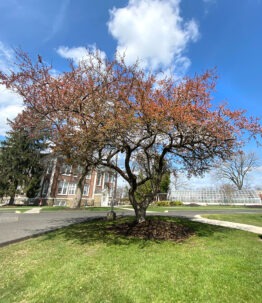Crabapple
Researched by Lornelle Mendoza
 Species: Malus spp.
Species: Malus spp.
Common name: Crabapple, the eating apple, cooking apple, culinary apple
Family: Rosaceae (Rose Family)
Clade: Angiosperms (flowering seed plants)
Coordinates: 39.70649347, -75.1201789
A tag using this number is placed near the tree.
Crabapple, which belongs to the Malus genus and includes domesticated apples, is a member of the larger Rosaceae, or rose family, which also includes cherries, pears, peaches, plums, apricots, and more. This group is characterized by woody trees and shrubs that prefer temperate climates. They’re highly adaptable to poor soil conditions, so this tree can tolerate pollution, soil acidity, and drought. Crabapple trees are deciduous and shed their leaves annually, so they are best viewed during the spring.
As angiosperms, crabapples belong to a large group of plants that produce flowers and fruits. The species produces eye-catching white, red or pink blossoms in early spring that attract bees for their nectar. The bees, in turn, transfer pollen between trees for reproduction. This species relies on bees to transfer pollen because it cannot self-fertilize. Read More
Campus Species Map
Student Researcher
 Lornelle Mendoza
Lornelle Mendoza
Lornelle Mendoza earned a Bachelor of Science in Biological Sciences in 2022.
Suggested Citation:
Mendoza, Lornelle. (2021, Dec). Crabapple. Rowan University Arboretum. Glassboro, NJ. https://arboretum.rowan.edu/trees/crabapple/
Questions to Explore
- Why are Crabapple trees able to tolerate drought?
- Can the fruit of the Crabapple be used to help with health conditions?
- What is “Fire Blight,” and how does this disease affect trees in the Rosaceae family?
- How were Crabapples important to Native Americans and early settlers?
References
Yale University. (2015, February 3). Crabapple Tree. Crabapple Tree | Yale Nature Walk. | Link
Li, H., Li, Y., Yu, J. et al. MdMYB8 is associated with flavonol biosynthesis via the activation of the MdFLS promoter in the fruits of Malus crabapple. Hortic Res 7, 19 (2020). | Link
Gilman, E. F., & Watson, D. G. (n.d.). Malus spp.: Crabapple. AskIFAS Powered by EDIS. | Link
Janoski, J., & Yiesla, S. (2021, June 2). Crabapple cultivars. The Morton Arboretum. | Link
Wartenberg, L. (2020, March 30). Can you eat crab apples? Healthline. | Link
Ohio Department of Natural Resources. (n.d.). American crabapple. | Link
Liu, F., Wang, M., & Wang, M. (2018). Phenolic compounds and antioxidant activities of flowers, leaves and fruits of five crabapple cultivars (malus mill. species). Scientia Horticulturae, 235, 460-467. | Link
Chen, F., Li, F., Lu, L., Zhang, X., Xu, X. and Li, D. (2014), Phenolic profile and changes in the antioxidant activity of crabapple (Malus domestica cv Royalty) fruit during maturation on the tree. Int J Food Sci Technol, 49: 1680-1688.
| Link
Rowan University Resources:
You may need to log into the Rowan University Library website.
Native Trees of the Midwest: Identification, Wildlife Value, and Landscaping Use | Link
How does Malus crabapple resist ozone? | Link
Phenotypic variation of floral organs in flowering crabapples and its taxonomic significance. | Link




















